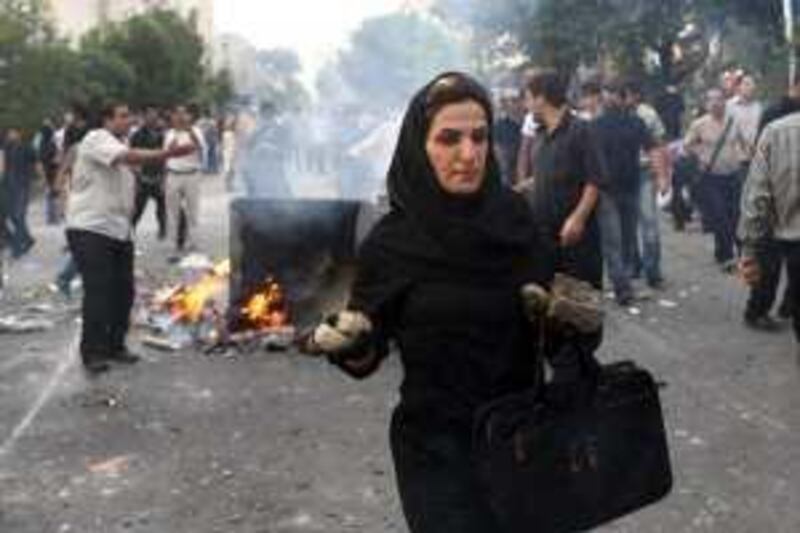A wall outside a shop in Tehran was covered every day with slogans in support of Mir Hossein Mousavi, the defeated presidential candidate. Every day, someone washed it clean. By the next morning the graffiti was there again. It is tempting to see this as a metaphor for the protest movement which erupted two weeks ago after the results were announced in Iran's June 12 election. This week, Mr Mousavi urged supporters to continue their struggle to overturn a result which is seen - rightly or wrongly - as having been rigged.
Bloggers and tweeters have been inventing ingenious ways to circumvent the government's policing of the internet. When it was closed down completely, details of the time and place of the next demonstration were passed from car window to car window. When the supreme leader, Ayatollah Ali Khamenei, called for an end to demonstrations last Friday, people took to the streets the next day in their thousands.
And yet, there is no doubt that the violence of the security forces has been a deterrent. "I'm not going to any more demonstrations," said one previously committed protester. "It's too dangerous." Basij - the paramilitary unit loyal to the supreme leader - are believed to have killed protesters. Estimates of the number of journalists, politicians, activists and demonstrators arrested in the past fortnight range from 450 to several thousand.
Many of the people who made up Mr Mousavi's "green tsunami" are sitting at home, "paralysed by fear" as one put it, dreading the knock on the door. Furthermore, as various analysts have pointed out, the regime has barely started to bare its teeth. Although what is going on at the moment is generally referred to in the press as a "crackdown" those who remember the massacre of thousands of political prisoners after the end of the Iran-Iraq war know that it can get much worse.
What then is to be the fate of the popular protest movement that has captured the sympathy of the world? "The outcome is clear," said one expatriate Iranian well-versed in the country's affairs, who asked to remain anonymous. "They will seek to emulate China: suppression and violence, total political control. They will create economic openings, through deals with the Americans, to create a measure of prosperity as the price for bypassing democracy. What they've learnt from the revolution is that the Shah lost his nerve - they won't make that mistake."
Baqer Moin, a former head of the BBC Persian service and author of an acclaimed biography of the late Ayatollah Ruhollah Khomeini, said that in comparison to the student demonstrations of 1999 and 2003, the protest movement is too widespread, too diverse and too connected to the political mainstream to make clamping down a realistic response. "They would have to kill a lot of people," he said. All eyes are on Qom at the moment - the centre of clerical power in Iran.
Akbar Hashemi Rafsanjani, a former president, and still a heavyweight figure, is believed to be seeking support for a challenge to the supreme leader's ruling on the election. Other signs augur less well for a compromise solution, however, such as the appointment of the hardline prosecutor Saeed Mortazavi as chief interrogator of protesters arrested in the demonstrations. Whatever strategy the government chooses to contain the unrest, there are some aspects of it which seem to have longer reaching consequences.
"Over the past month, millions of people have become politicised," said Moin. "You can't depoliticise them overnight." Comparing Iran during the election to just a few months earlier, the differences are palpable. Four years of oppressive restrictions on social life, media and the arts had left people apathetic and depressed, seeking a space in their inner life which was not available outside. "I try to do something every day to keep my spirit alive," one young artist said in February. For him, then, this meant painting, listening to a song or reading a poem.
Life for young people in the Islamic republic seemed not only colourless, but lonely. There was nowhere people could gather, unless they were wealthy and had a large house and understanding parents, and interact with each other free from the watchful eye of state authorities. In the run-up to the elections, however, after the electrifying presidential debates on TV, people were gathering on the streets in their thousands, singing songs and dancing.
It might have remained what one more politically engaged participant sternly deemed "a social event" had the election result been different, or less suspiciously in Mahmoud Ahmadinejad's favour. Each protest, and the brutal response of the security forces, seemed to bond people further. Strangers, young and old, men and women, started chatting to each other through car windows. Even though the government blocked Facebook and text messages, other social networking tools such as Twitter helped cement their sense of community.
"It was like in the revolution," one man said. "People were pulling strangers into their houses and putting them in front of fires to get rid of the tear gas." More even than the political radicalisation, it is hard to see how this intoxicating sense of solidarity in such a young population can fail to be dangerous for the government. "I never knew that I have a lot in common with people around my city or country," said one young demonstrator. "But now we all know we have something in common and we can count on each other.
"Maybe for a while we will not have another demonstration, but we'll never forget our social act." It is important to remember that this sense of a rubicon having been crossed was the same - albeit much more limited - during the student protests of 1999. Although these protests are more widespread, they do not represent all of Iranian society. For now, it seems likely that this inchoate movement will be disarmed, either by political compromise, or by brutal suppression.
But according to Rami Khouri, an expert in Middle East politics at the American University of Beirut, "once you unleash this spirit of fearless resistance and defiance it will come up again, somewhere, somehow, like Solidarnosc in Poland." It is impossible at this stage, he said, to tell what form it might take: "These things percolate slowly." Analogies from other countries, although useful, are not exact. Although the government itself has raised the spectre of the "velvet revolution", referring to the student protest-led overthrow of the communist Czech government in 1989, this was, as the historian Tony Judt put it, "Gorbachev's revolution", ultimately enabled by the withdrawal of the implicit threat of force from Moscow.
Another parallel evoked, that of the Chinese Communist Party's suppression of protesters in and around Tiananmen Square in 1989, raises the question of whether a cash-strapped Iranian government grappling with low oil prices and high inflation can deliver the same opportunities for prosperity which facilitated the closing down of dissent in China. There are few examples of successful street-led uprisings in the Arab Middle East, as Rami Khouri points out, "it was mostly coups by colonels".
Even the trajectory of Iran's own revolution of 1979 is not necessarily a useful indicator; the protesters lack anything like the ideological coherence provided by Ayatollah Khomeini. As many commentators have pointed out, Mr Mousavi is as much part of the system as the supreme leader himself. However it plays out, there is a sense in Iran that something has changed, even as demonstrators hang up their green ribbons and return to work.
"Normal life has started," one young woman who returned to work said. "But it's not like in the past. It's hard to get you back to the cage when you know what joyful flight is." * The National





